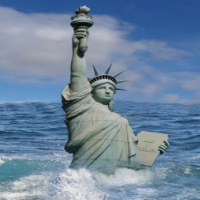Statue of Liberty and Stonehenge among Landmark Sites Called Vulnerable to Climate Change Effects
 (photo: Getty Images)
(photo: Getty Images)
By Jonah Bromwich, New York Times
Stonehenge eroding under the forces of extreme weather. The city of Venice slowly collapsing into its canals. The gradual flooding of the Statue of Liberty.
Images like these, familiar from Hollywood climate-catastrophe thrillers, were evoked by a joint report (pdf), released Thursday by UNESCO, the United Nations Environment Program and the Union of Concerned Scientists, that detailed the threat climate change could pose to World Heritage sites on five continents.
Adam Markham, the deputy director for climate and energy at the Union of Concerned Scientists and the report’s lead author, said that while many of the sites were bound to be affected by factors including a rise in sea levels, intense storms and wildfires, planning could go a long way toward protecting them.
“It is a very tough challenge, but if we recognize the scale of the problem — and I don’t think most people realize how big it is or how fast the changes are coming — then I think there is a lot we can do,” he said.
The report highlights 31 sites in 29 countries that have already felt some impact from climate change, including well-known tourist destinations like Easter Island and Yellowstone National Park. It was drawn from peer-reviewed science literature, technical reports and local experts, as well as domestic evaluations of the sites prepared for the World Heritage Committee.
Although the report emphasizes the importance of the recent Paris climate accord, Markham said that emissions already affecting the climate are likely to create “a lot of change and impact.”
“We don’t have enough resources to save every threatened asset,” he said. “Can we save every lighthouse that is on an eroding cliff? Probably not. So there are going to have to be hard choices made in every country.”
Thirteen listed heritage sites were examined in comprehensive case studies intended to demonstrate the way climate change has already had an impact. In a study of the Statue of Liberty, for instance, the effects of Hurricane Sandy, which scientists have shown were exacerbated by a rise in the sea level, are explored at length.
Rebecca Beavers, the coastal adaptation coordinator of the National Park Service, who helps the agency plan for the impact of climate change and was an adviser on the report, said the damage to the facilities and infrastructure at the Statue of Liberty from the 2012 storm had precipitated a new focus on how best to contend with extreme weather.
“I think that it’s important to recognize that adaptation is continuous change,” Beavers said. “It’s not isolated action; it’s not a single step. It really is a process.”
The report includes a series of recommendations for government agencies, the tourism industry and heritage site managers. It emphasizes that the sites themselves represent a trove of historical information on human responses to extreme weather and that the archaeological data they hold could help guide policymakers.
Markham, who is British, said he personally was very upset about what was happening to Skara Brae, a 5,000-year-old Neolithic settlement that is one of many sites off the coast of Scotland at risk from coastal erosion.
“This is the famous one, which I’ve never seen and I want to be able to see, but I care about all of those sites,” he said. “For me, that is my cultural heritage, disappearing into the ocean.”
To Learn More:
World Heritage and Tourism in a Changing Climate (UNESCO, UNEP and Union of Concerned Scientists) (pdf)
Rising Sea Levels May Disrupt Lives of 13 Million Americans (by Tatiana Schlossberg, New York Times)
Global Warming Sends Earth’s Sea Levels Rising Faster than Any Time in Past 2,800 Years (by Seth Borenstein, Associated Press)
- Top Stories
- Unusual News
- Where is the Money Going?
- Controversies
- U.S. and the World
- Appointments and Resignations
- Latest News
- Musk and Trump Fire Members of Congress
- Trump Calls for Violent Street Demonstrations Against Himself
- Trump Changes Name of Republican Party
- The 2024 Election By the Numbers
- Bashar al-Assad—The Fall of a Rabid AntiSemite






Comments